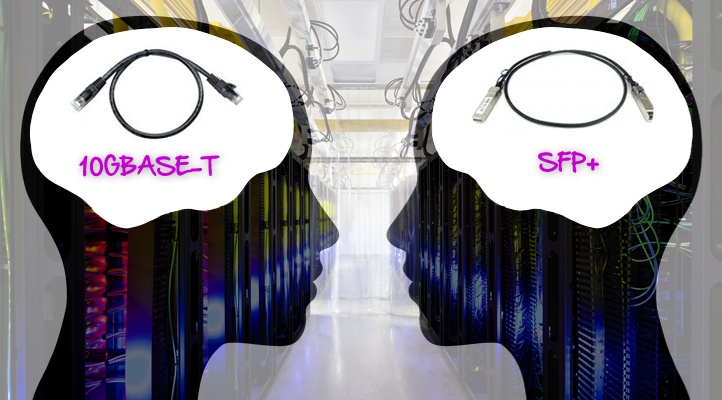Les technologies SFP+ et 10GBASE-T rivalisent dans le centre de données
Alors que son prix et sa consommation d'énergie ne cessent de baisser, la technologie 10GBASE-T rivalise avec la technologie SFP+ dans les environnements de centres de données à 10 Gbit/s basés sur le rack qui utilisent des commutateurs dans la partie supérieure du rack.
Let’s take a minute to review the pros and cons of each option so you can make an informed decision and select the solution that best fits your need.
Power and Latency
Recent advancements have allowed switch manufacturers to significantly lower power consumption on 10GBASE-T server and switch ports. While early versions of 10GBASE-T switches required up to 12 Watts per port, switch vendors now offer a range of 1.5 to 4 W per port depending on distance.
Despite the reduced power consumption for 10GBASE-T, the small form factor pluggable (SFP+) interface that has been widely deployed for 10 gigabit ToR switches continues to use less power—typically less than 1 W per port.
With simplified electronics, SFP+ also offers better latency—typically about 0.3 microseconds per link. 10GBASE-T latency is about 2.6 microseconds per link due to more complex encoding schemes within the equipment.
When you consider an environment where data transmits through three switches, 10GBASE-T therefore introduces nearly an 8 microsecond delay, while SFP+ introduces less than 1 microsecond delay.
Lower power consumption and lower latency makes SFP+ well suited for large high-speed supercomputing applications where latency is a critical factor and where high port counts can add up to significant power savings.
Cost and Interoperability
While 10GBASE-T switches have been available since 2008, and as an add-on for server platforms, 2012 saw vendors begin to ship server and storage devices with 10GBASE-T LAN on motherboard (LOM) technology. As a result, more than a half million 10GBASE-T server ports shipped in 2012.
As this trend continues, the shipment of 10GBASE-T ports is projected to reach upwards of 5 million for 2013. The increase in proliferation is helping to drive down the cost of 10GBASE-T technology.
SFP+ DAC solutions available from switch vendors are often proprietary and cost more than SFP+ DACs and category 6A patch cords from cabling vendors. With 10GBASE-T rapidly becoming the de factor LOM technology, the use of SFP+ can means an additional cost of adapters for the servers. In comparing one of the latest SFP+ and 10GBASE-T ToR switches, the cost of 10GBASE-T ranges from 20% to 40% less.

10GBASE-T also has the advantage of being an interoperable, standards-based technology that uses the familiar RJ45 connector and provides backwards compatibility with legacy networks via autonegotiation. The ability to autonegotiate between 1 and 10 gigabit speeds allows 10GBASE-T server upgrades to occur on an evolutionary, as-needed basis. SFP+ solutions do not support autonegotiation and are limited with little or no backwards compatibility.
As a standards-based, category 6A twisted-pair technology, 10GBASE-T can offer more design flexibility using a structured cabling approach for longer distances of up to 100 meters, as well as shorter ToR switch-server connections using category 6A patch cords. A structured cabling approach means that Category 6A cables can be field terminated on patch panels to any length for clean, slack-free cable management.
SFP+ direct attach cables (DAC) offer less than a 10 meter distance, and they are factory terminated and must be purchased in pre-determined lengths. SFP+ active optical cables (AOC) can support longer distances up to 100 meters, but at a much higher cost and with the same limitations as SFP+ DAC for point to point connections.
Make an Informed Decision
When faced with choosing between SFP+ and 10GBASE-T, carefully consider your needs. If power consumption and lower latency are critical, SFP+ might be the solution for you. If cost, flexibility and scalability are more important, you'll likely want to consider 10GBASE-T.
Regardless of which solution is for you, it's important to remember that high quality cabling from reputable manufacturers will help ensure performance and reliability-especially since ToR switch-server connections are touched frequently in moves, adds and changes. Belden offers both SFP+ Direct Attached Cables for SFP+ and category 6A patch cords for 10GBASE-T-and the experts to help you choose.
Our SFP+ Direct Attached Cables feature Belden Lightskew Series cable with optimal delay skew and zinc die-cast connectors with easy pull-to-release action. Part of the Belden IBDN System 10GX, our category 6A patch cords are available with an integral boot for improved strain relief and patented Bonded-Pair technology that maintains stable performance when subjected to everyday handling stresses. Belden category 6A cords are also available as Traceable patch cords for easy tracing of connections and integration with DCIM systems.

